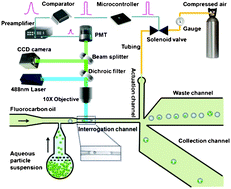Droplet sorting based on the number of encapsulated particles using a solenoid valve†
Abstract
Droplet microfluidics provides a high-throughput platform for screening subjects and conditions involved in biology. Droplets with encapsulated beads and cells have been increasingly used for studying molecular and cellular biology. Droplet sorting is needed to isolate and analyze the subject of interest during such screening. The vast majority of current sorting techniques use fluorescence intensity emitted by each droplet as the only criterion. However, due to the randomness and imperfections in the encapsulation process, typically a mixed population of droplets with an uneven number of encapsulated particles results and is used for screening. Thus droplet sorting based on the number of encapsulated particles becomes necessary for isolating or enriching droplets with a specific occupancy. In this work, we developed a fluorescence-activated microfluidic droplet sorter that integrated a simple deflection mechanism based on the use of a solenoid valve and a sophisticated signal processing system with a microcontroller as the core. By passing droplets through a narrow interrogation channel, the encapsulated particles were detected individually. The microcontroller conducted the computation to determine the number of encapsulated particles in each droplet and made the sorting decision accordingly that led to actuation of the solenoid valve. We tested both fluorescent beads and stained cells and our results showed high efficiency and accuracy for sorting and enrichment.


 Please wait while we load your content...
Please wait while we load your content...